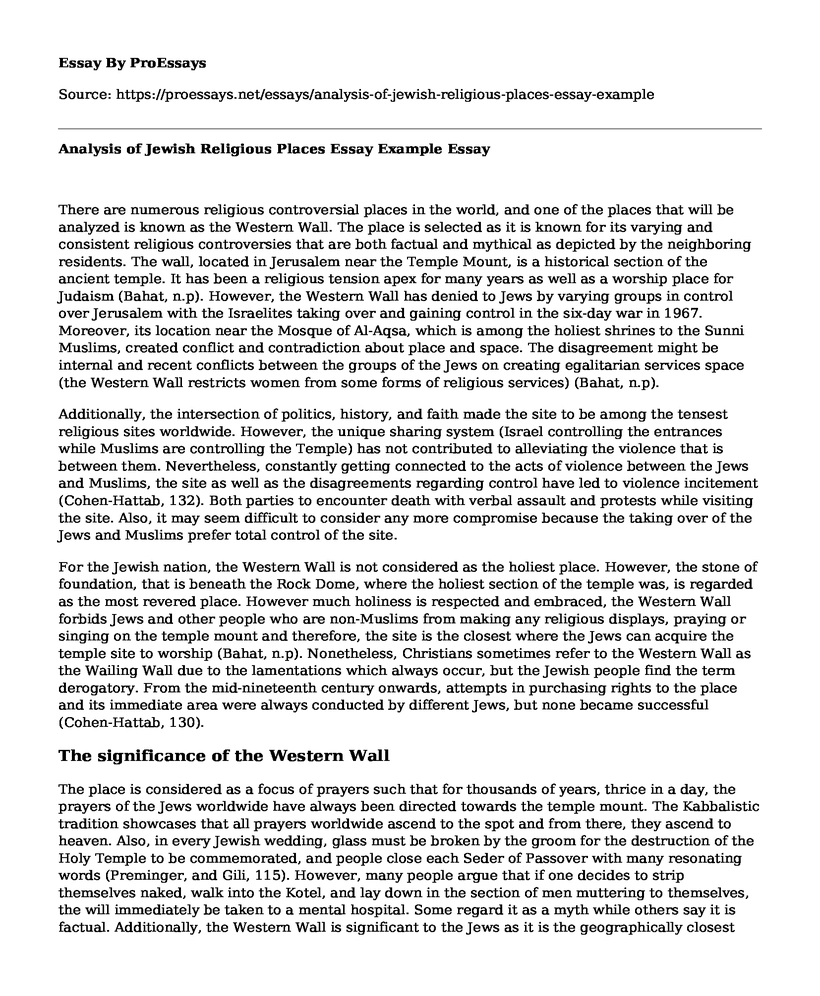There are numerous religious controversial places in the world, and one of the places that will be analyzed is known as the Western Wall. The place is selected as it is known for its varying and consistent religious controversies that are both factual and mythical as depicted by the neighboring residents. The wall, located in Jerusalem near the Temple Mount, is a historical section of the ancient temple. It has been a religious tension apex for many years as well as a worship place for Judaism (Bahat, n.p). However, the Western Wall has denied to Jews by varying groups in control over Jerusalem with the Israelites taking over and gaining control in the six-day war in 1967. Moreover, its location near the Mosque of Al-Aqsa, which is among the holiest shrines to the Sunni Muslims, created conflict and contradiction about place and space. The disagreement might be internal and recent conflicts between the groups of the Jews on creating egalitarian services space (the Western Wall restricts women from some forms of religious services) (Bahat, n.p).
Additionally, the intersection of politics, history, and faith made the site to be among the tensest religious sites worldwide. However, the unique sharing system (Israel controlling the entrances while Muslims are controlling the Temple) has not contributed to alleviating the violence that is between them. Nevertheless, constantly getting connected to the acts of violence between the Jews and Muslims, the site as well as the disagreements regarding control have led to violence incitement (Cohen-Hattab, 132). Both parties to encounter death with verbal assault and protests while visiting the site. Also, it may seem difficult to consider any more compromise because the taking over of the Jews and Muslims prefer total control of the site.
For the Jewish nation, the Western Wall is not considered as the holiest place. However, the stone of foundation, that is beneath the Rock Dome, where the holiest section of the temple was, is regarded as the most revered place. However much holiness is respected and embraced, the Western Wall forbids Jews and other people who are non-Muslims from making any religious displays, praying or singing on the temple mount and therefore, the site is the closest where the Jews can acquire the temple site to worship (Bahat, n.p). Nonetheless, Christians sometimes refer to the Western Wall as the Wailing Wall due to the lamentations which always occur, but the Jewish people find the term derogatory. From the mid-nineteenth century onwards, attempts in purchasing rights to the place and its immediate area were always conducted by different Jews, but none became successful (Cohen-Hattab, 130).
The significance of the Western Wall
The place is considered as a focus of prayers such that for thousands of years, thrice in a day, the prayers of the Jews worldwide have always been directed towards the temple mount. The Kabbalistic tradition showcases that all prayers worldwide ascend to the spot and from there, they ascend to heaven. Also, in every Jewish wedding, glass must be broken by the groom for the destruction of the Holy Temple to be commemorated, and people close each Seder of Passover with many resonating words (Preminger, and Gili, 115). However, many people argue that if one decides to strip themselves naked, walk into the Kotel, and lay down in the section of men muttering to themselves, the will immediately be taken to a mental hospital. Some regard it as a myth while others say it is factual. Additionally, the Western Wall is significant to the Jews as it is the geographically closest site that they can get to and see the former temple's site without being under the jurisdictions of the Muslims (Cohen-Hattab, 130).
Works Cited
Bahat, Dan. The Jerusalem Western Wall Tunnel. Jerusalem: Israel Exploration Society, 2013.
Cohen-Hattab, Kobi. "Struggles at holy sites and their outcomes: the evolution of the Western Wall Plaza in Jerusalem." Journal of Heritage Tourism 5.2 (2010): 125-139.
Preminger, Briana, and Gili S. Drori. "How institutions get materialized in space: "Spatialized logics" along Jerusalem's Western Wall." How Institutions Matter! Emerald Group Publishing Limited, 2016. 101-136.
Cite this page
Analysis of Jewish Religious Places Essay Example. (2022, Dec 10). Retrieved from https://proessays.net/essays/analysis-of-jewish-religious-places-essay-example
If you are the original author of this essay and no longer wish to have it published on the ProEssays website, please click below to request its removal:
- Some Questions on Religion. Essay Example.
- Emotionally Healthy Spirituality by Scazzero Essay
- Essay Sample on Hebrews With the Issue of Marriage
- Comparison of Buddhism and Confucianism Essay
- Dalai Lama View on Practice of Universal Compassion Essay
- Essay on Confucianism in Understanding Virtue Ethics: Beyond Historical Labels
- Paper Example on the Church: A Living Tradition of Continuity & Memory







